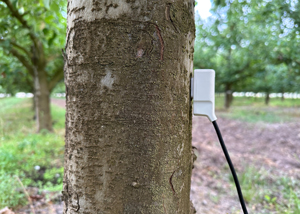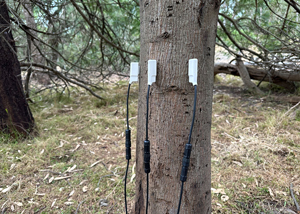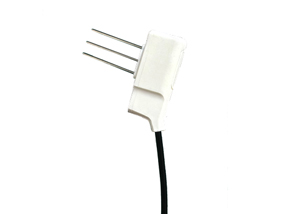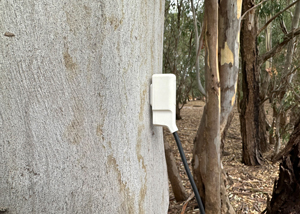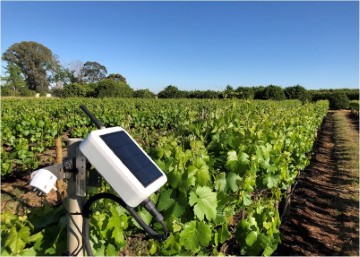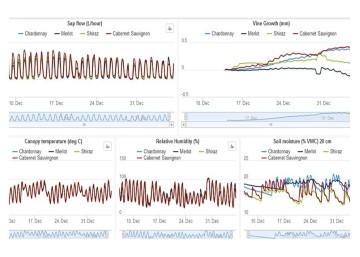Stem Water Content Sensor.
A Heat Pulse Probe for Sapwood Moisture Content.
Overview
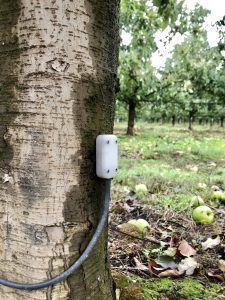 A low cost, calibrated, SDI-12 enabled, heat pulse probe;
A low cost, calibrated, SDI-12 enabled, heat pulse probe;- A versatile digital solution so you can allocate more funds to sensors and less to data loggers;
- Increase sample size and replication;
- Output calibrated water content, temperature, specific heat capacity and more;
- Calibrated and scientifically backed with peer-reviewed publications.
The Stem Water Content Sensor is a combined sensor with Implexx Sap Flow Sensor. In a single device, measure stem water content, sap flow (water use), and stem temperature. Stem water content is also referred to as moisture content or sapwood water content. Measure other stem tissues, such as bark or heartwood, with the stem water content sensor. The stem water content sensor is ideal for plant water relations, water storage, capacitance, hydrology, drought and stress strategies, and more.
Stem water content measurements are based on the "heat pulse probe" design. Heat pulse probes have been used by scientists and researchers for decades to measure the moisture content of samples such as soils. The heat pulse probe is based on the theory of thermal conduction therefore the stem water content measurements are based on theoretical principles of thermal physics.
The Implexx Sap Flow Sensor is a versatile solution for measuring stem water conten, sap flow and plant water relations for scientists. Connect the Implexx Sap Flow Sensor to our range data logging solutions or we can assist you in connecting the Implexx Sap Flow Sensor to your existing dataloggers, IoT devices, RTU's, DAQ's and more.
Stem Water Content Explained.
A comprehensive guide on stem water content, and how it is measured via a heat pulse probe, can be found via this weblink.
Soil Sensors and Heat Pulse Probes for Stem Water Content.
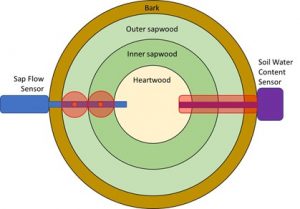 In old research, scientists relied on soil water content sensors to measure stem water content. Soil water content sensors include capacitance (frequency domain reflectometry), time domain reflectometry (TDR) and others. While this approach provided worthwhile insights into plant water relations, there were significant methodological issues including:
In old research, scientists relied on soil water content sensors to measure stem water content. Soil water content sensors include capacitance (frequency domain reflectometry), time domain reflectometry (TDR) and others. While this approach provided worthwhile insights into plant water relations, there were significant methodological issues including:
- Calibration: soil sensors are calibrated for soils and creating a calibration curve for stems is time consuming and difficult.
- Accuracy: as the calibration is difficult, the accuracy of sensors is questionable.
- Misinterpretation: the needles or probes of soil sensors are usually 50 mm long or longer and water content is an integration over the entire length of the probe. If the probe is installed across different plant tissues, such as bark, sapwood and heartwood, then moisture content data is an integration of the entire stem. This may lead to erroneous conclusions on the importance of various patterns and trends.
Heat pulse probes, such as the Implexx Sap Flow Sensor for Stem Water Content, overcome the shortcomings of soil sensors because:
- High spatial resolution: the Implexx Sap Flow Sensor can measure multiple radial depths and within specific stem tissues.
- Theoretical principles: the heat pulse probe is based on the theory of thermal conduction therefore it does not require a specific calibration curve.
- Accuracy: the Implexx Sap Flow Sensor for Stem Water Content has an accuracy of better than 4 %.
Implexx Sap Flow Sensor for Stem Water Content Features.
- Easy to install and requires little ongoing maintenance;
- Outputs a comprehensive range of 33 parameters per measurement;
- Or simplifies it down to a single output of calibrated stem water content and sap flow;
- Output raw temperature data for your own models and equations;
- SDI-12 protocol so it can be supported by a large range of data loggers.
Versatile Data Logging Solutions.
The Implexx Sap Flow Sensor is supported by the SDI-12 protocol which gives it tremendous flexibility to connect to many data logging devices.
Implexx is supported by a world-wide team of dealers who can provide a comprehensive range of data logging solutions. This includes the complete range of Campbell Scientific data loggers and many more brands.
Alternatively, the Implexx Sap Flow Sensor can be integrated into your existing data logging infrastructure. Implexx provides a comprehensive range of guides and manuals to assist you, or you can contact us for further assistance.
Low Power, Less Management.
The Implexx Sap Flow Sensor is a heat pulse style sap flow sensor therefore it requires relatively low power. The Implexx engineers have added features to the Implexx Sap Flow Sensor to further improve the power efficiency of our sap flow sensor. The Implexx Sap Flow Sensor is therefore an ideal sensor for measuring sap flow in forests and remote field sites.
In our experience, we've installed the Implexx Sap Flow Sensor at field sites with the following power requirements:
- A 20W solar panel, with a 12V 9 amp hour battery, supporting 12 x Implexx Sap Flow Sensors plus a modem, 12 x dendrometers, soil moisture and air temperature sensors;
- A 5W solar panel, with a 12V 7 amp hour battery, supporting 2 x Implexx Sap Flow Sensors;
- A stand-alone 12V, 9 amp hour battery, with a 30-minute logging interval, supporting 1 x Implexx Sap Flow Sensor for 30 days.
Multiple Measurement Points.
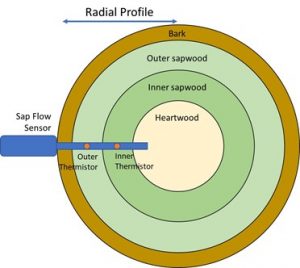 The Implexx Sap Flow Sensor is configured to measure two sapwood radial depths: outer and inner. Multiple measurement points in the sapwood are advantageous because:
The Implexx Sap Flow Sensor is configured to measure two sapwood radial depths: outer and inner. Multiple measurement points in the sapwood are advantageous because:
- increases the accuracy of the Implexx Sap Flow Sensor over older technology such as the thermal dissipation or Granier probe;
- the outer and inner sapwood provide insights into plant physiological processes; and
- the ratio of outer to inner sap flow has been used as a measure of water stress.
The outer and inner measurement depths are located at 10 and 20 mm, respectively.
Specifications
| Feature | Specification |
|---|---|
| Measurement Range | 0 to 100 % Volumetric Water Content |
| Measurement Accuracy | < 4 % |
| Resolution | 0.01 % |
| Needle Dimensions | 30 mm Length x 1.3 mm Diameter |
| Position of Thermistors | Outer: 10 mm | Inner: 20 mm |
| Distance Between Needles | 6 mm |
| Epoxy Body Dimensions | 40 x 16 mm |
| Probe Materials | 316 marine grade stainless steel |
| Temperature Range | -30 to +70 °C |
| Thermistor Response Time | 200 mSec |
| Heater Resistance | Output | 39 ohms (typical) | 400 J/m (typical) |
| Power Input | 12 VDC |
| Power Consumption | Idle: 4 mA; | Measure: 270 mA | Typical Measurement Cycle: 0.4 mAhr |
| Sensor Output | SDI-12 (ver. 1.4) |
| Cable Length | 5 m (standard) | 60 m (maximum) |
Manuals & Docs
Datasheet
Scientific Publication on Method and Sensor Design
- Forster 2020 Conduction and convection in heat pulse methods
- Forster 2019 The Dual Method Approach resolves measurement range limitations of HPV sap flow sensors
Installation Guides and Configuring SDI-12 Parameters
- Quick Start Guide - Quick Installation of Implexx Sap Flow Sensor
- A Longer Guide - Installation of Implexx Sap Flow Sensor
- Small Stem Installation Tips
- Implexx Sap Flow Sensor Integrators Guide v1_3
- SDI-12 Parameter Outputs Explained
- Quick Start Guide - TBS03 SDI-12 Commander
- Quick Start Guide - PC400 Terminal Emulator
- Data Logger Program: Implexx Sap Flow Sensor 01 Sensor for CR300
- Data Logger Program: Implexx Sap Flow Sensor 10 Sensors for CR300
- Correction for Probe Misalignment


